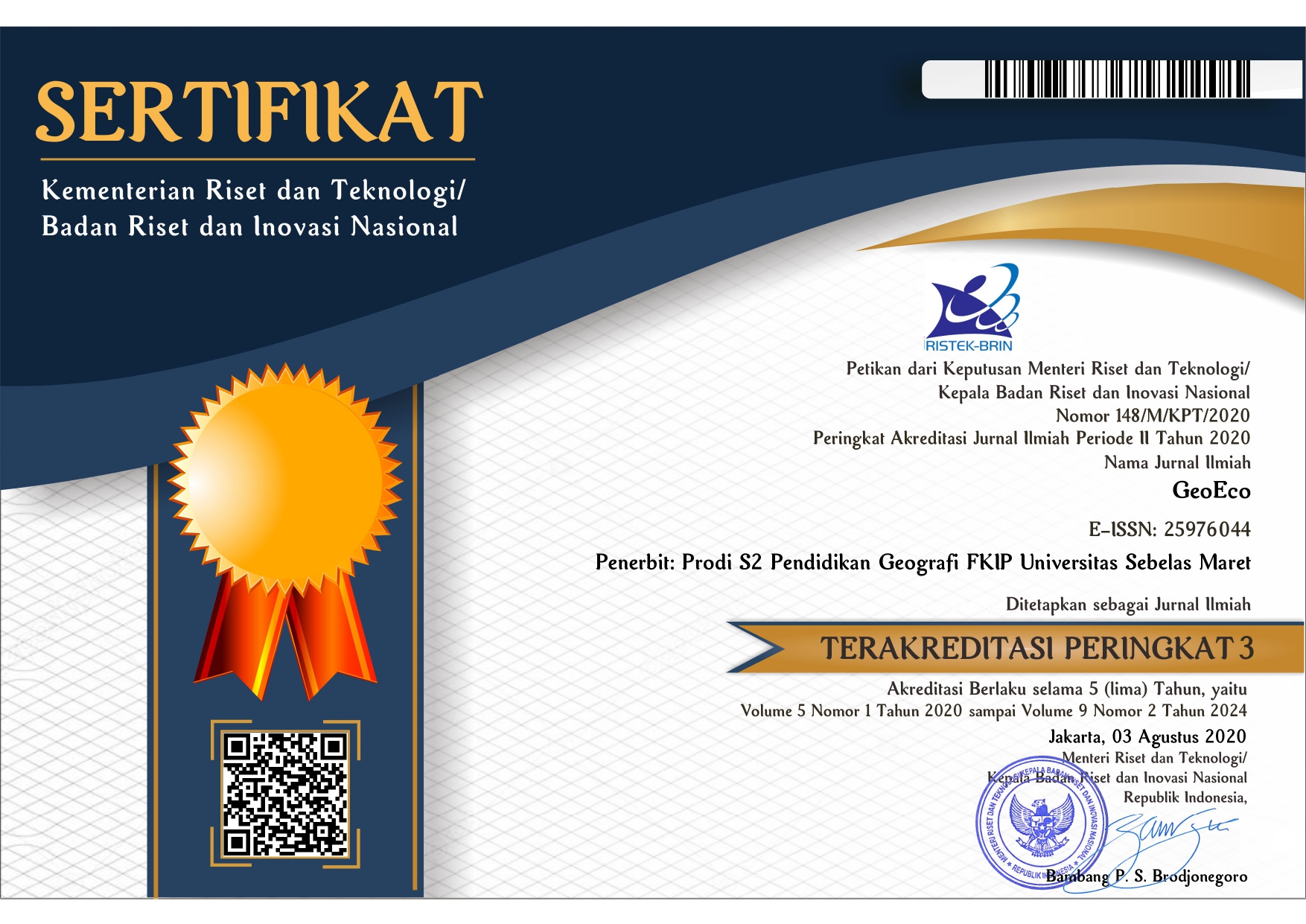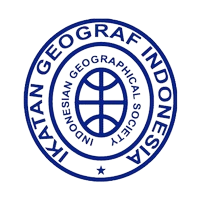EMERGENCES OF GULON INFORMAL SETTLEMENT IN SURAKARTA CITY: PERSPECTIVES ON THE PRODUCTION OF SPACE AND RHYTHMANALYSIS
Abstract
Increasing population growth and limited residential land occur in most urban areas in Indonesia. The government has well-observed regional spatial planning (RTRW) and regulations, but there are often deviations, such as the emergence of informal settlements. This study seeks to clarify the background of the establishment of informal settlement through the production of space theory and identify how society shapes the rhythm of life in producing space. Data collection is carried out by observation, interview, participatory mapping, and temporal imagery. This research uses progressive regressive methods with the production of space theory perspective and rhythmanalysis. Rhythmanalysis is used to complement the exposition of the production of space theory. It is known that the settlement space began to be formed in 2004. Residents interpret the Gulon informal settlement location as a strategic and effective cheap livelihood location. This choice of place to live is further strengthened by the similarity of the community's economic conditions which are increasingly deteriorating, made worse by the impact of the Covid-19 pandemic. This situation encourages interaction in the rhythm of people's lives so that the concept of residential space is formed. Polyrhythmics strengthen the phenomenon of space utilization.
Keywords
Full Text:
PDFReferences
Adam, B. (1998). Timescapes of Modernity: The Environment and Invisible Hazards. Routlege.
Alhadeff-Jones, M. (2019). Beyond space and time—Conceiving the rhythmic configurations of adult education through Lefebvre’s rhythmanalysis. Zeitschrift Für Weiterbildungsforschung, 42(2), 165–181. https://doi.org/10.1007/s40955-019-0133-0
Anggana, A. F., & Susanti, P. D. (2020). Evaluation of water quality in the swamp river border using water quality index. Journal of Degraded and Mining Lands Management, 7(4), 2373–2379. https://doi.org/10.15243/jdmlm
BPS. (2022). Kota Surakarta dalam Angka. In Badan Pusat Statistik Kota Surakarta. Badan Pusat Statistik Kota Surakarta.
Buchori. (2014). Penuntasan Kawasan Permukiman Kumuh. Buletin Cipta Karya, 1–34.
Edensor, T. (2010). Walking in rhythms: Place, regulation, style and the flow of experience. Visual Studies, 25(1), 69–79. https://doi.org/10.1080/14725861003606902
Ellegård, K. (2018). Thinking time geography: Concepts, methods and applications. Routledge.
Farrington, A. (2021). Reorienting The Production of Space: Rhythmanalysis, desire, and “The Siege of the Third Precinct.” Environment and Planning C: Politics and Space, 39(5), 938–954. https://doi.org/10.1177/2399654420970948
Handayani, W., Chigbu, U. E., Rudiarto, I., & Surya Putri, I. H. (2020). Urbanization and increasing flood risk in the Northern Coast of Central Java-Indonesia: An assessment towards better land use policy and flood management. Land, 9(10). https://doi.org/10.3390/LAND9100343
Hasanawi, A., Masturi, H., & Hasanawi, A. (2019). Improvement of Community Governance to Support Slum Upgrading in Indonesia. The Indonesian Journal of Development Planning, 3(3), 347–358. https://doi.org/10.36574/jpp.v3i3.88
Holden, E., & Norland, I. T. (2005). Three challenges for the compact city as a sustainable urban form: Household consumption of energy and transport in eight residential areas in the Greater Oslo Region. Urban Studies, 42(12), 2145–2166. https://doi.org/10.1080/00420980500332064
Lefebvre, H. (1991). The Production of Space. Wiley-Blackwell Publishing.
Lefebvre, H. (2004). Rhythmanalysis: Space, time and everyday life. Continuum.
Leite Mariante, G., Ma, T. Y., & Van Acker, V. (2018). Modeling discretionary activity location choice using detour factors and sampling of alternatives for mixed logit models. Journal of Transport Geography, 72(September), 151–165. https://doi.org/10.1016/j.jtrangeo.2018.09.003
Lutz, W., Butz, W. P., & KC, S. (2014). World Population and Human Capital in The Twenty-First Century. Oxford University Press.
Lyon, D. (2016). Doing audio-visual montage to explore time and space: the everyday rhythms of billingsgate fish market. Sociological Research Online, 21(3), 1–12. https://doi.org/10.5153/sro.3994
Nash, L. (2020). Performing Place: A Rhythmanalysis of the City of London. Organization Studies, 41(3), 301–321. https://doi.org/10.1177/0170840618789161
Nasongkhla, S., & Sintusingha, S. (2013). Social Production of Space in Johor Bahru. Urban Studies, 50(9), 1836–1853. https://doi.org/10.1177/0042098012465907
Nicola, M., Alsafi, Z., Sohrabi, C., Kerwan, A., Al-Jabir, A., Iosifidis, C., Agha, M., & Agha, R. (2020). The socio-economic implications of the coronavirus pandemic (COVID-19): A review. International Journal of Surgery, 78(April), 185–193. https://doi.org/10.1016/j.ijsu.2020.04.018
Nursyahbani, R., & Pigawati, B. (2015). Kajian Karakteristik Kawasan Pemukiman Kumuh Di Kampung Kota (Studi Kasus: Kampung Gandekan Semarang). Teknik Perencanaan Wilayah Kota, 4(2), 267–281.
Pramantha, R. Q., Agustian, E., Suminar, L., & Refnitasari, L. (2021). The characteristics of riverbank slum settlement in Indonesia. Case study: Depok, Palembang, Surabaya, and Surakarta. IOP Conference Series: Earth and Environmental Science, 916(1). https://doi.org/10.1088/1755-1315/916/1/012012
Prihatin, R. B. (2016). Alih Fungsi Lahan Di Perkotaan (Studi Kasus Di Kota Bandung Dan Yogyakarta). Jurnal Aspirasi, 6(2), 105–118. https://doi.org/10.22212/aspirasi.v6i2.507
Sastika, A., & Yasir, A. (2017). Karakteristik Permukiman Di Tepian Sungai Studi Kasus: Permukiman di Tepian Sungai Musi. Jurnal Koridor, 8(2), 83–88.
Simpson, P. (2012). Apprehending everyday rhythms: Rhythmanalysis, time-lapse photography, and the space-times of street performance. Cultural Geographies, 19(4), 423–445. https://doi.org/10.1177/1474474012443201
Vadrevu, K., Heinimann, A., Gutman, G., & Justice, C. (2019). Remote sensing of land use/cover changes in South and Southeast Asian Countries. International Journal of Digital Earth, 12(10), 1099–1102. https://doi.org/10.1080/17538947.2019.1654274
Winkler, K., Fuchs, R., Rounsevell, M., & Herold, M. (2021). Global land use changes are four times greater than previously estimated. Nature Communications, 12(1). https://doi.org/10.1038/s41467-021-22702-2
Worldometer. (2022). Countries in the world by population (2022). Worldometer.
Yusup, Y. (2016). Resiliensi Komunitas di Kawasan Rawan Bencana Gunungapi Merapi dalam Perspektif Konstruksi Ruang-Waktu ( Program Studi Perencanaan Wilayah dan Kota ) Institut Teknologi Bandung (Issue Februari). Institut Teknologi Bandung.
Zehra, D., Mbatha, S., Campos, L. C., Queface, A., Beleza, A., Cavoli, C., Achuthan, K., & Parikh, P. (2019). Rapid flood risk assessment of informal urban settlements in Maputo, Mozambique: The case of Maxaquene A. International Journal of Disaster Risk Reduction, 40(August), 101270. https://doi.org/10.1016/j.ijdrr.2019.101270
Zhong, C., Wang, T., Zeng, W., & Müller Arisona, S. (2012). Spatiotemporal visualisation: A survey and outlook. Communications in Computer and Information Science, 242 CCIS, 299–317. https://doi.org/10.1007/978-3-642-29758-8_16
Refbacks
- There are currently no refbacks.











.png)

